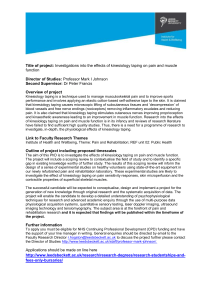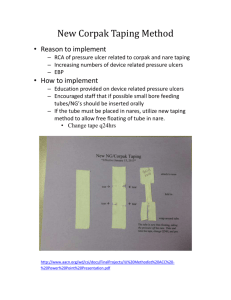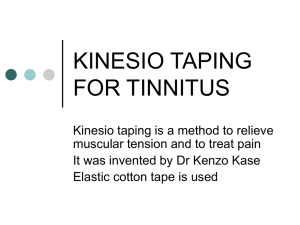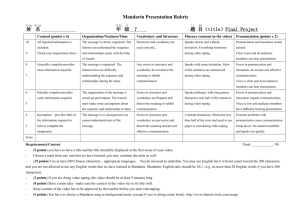The Effect of Kinesiology Taping on Respiratory Muscle Strength
advertisement
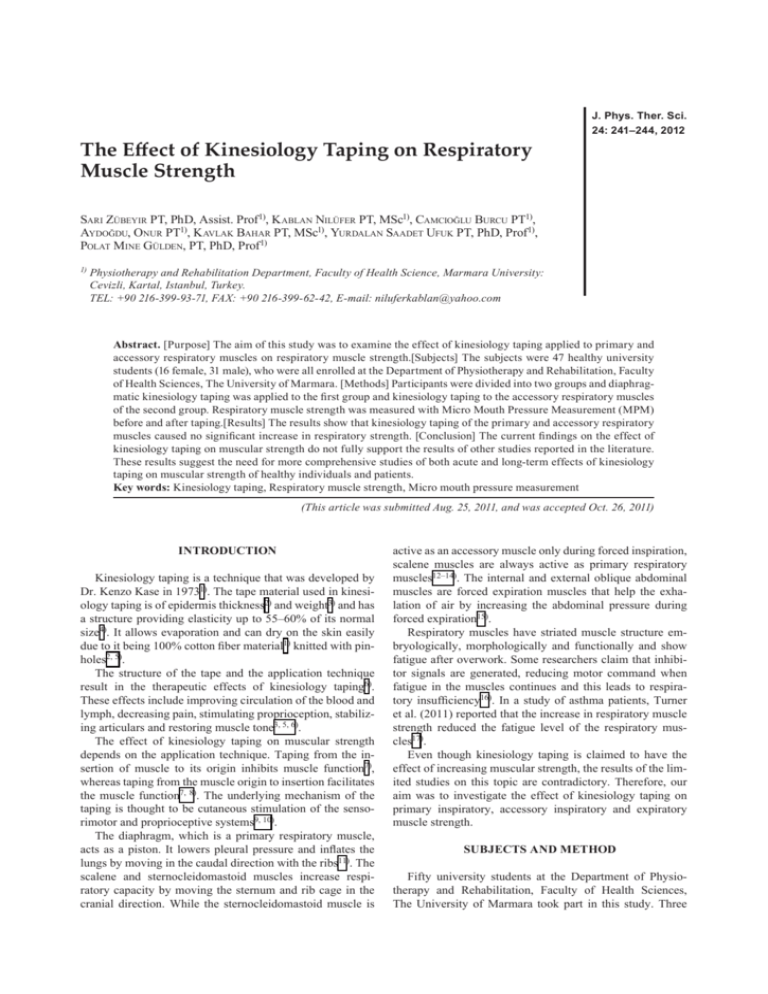
J. Phys. Ther. Sci. 24: 241–244, 2012 ȱěȱȱ¢ȱȱȱ¢ȱ ȱ SARI ZÜBEYIR PT, PhD, Assist. Prof1), KABLAN NILÜFER PT, MSc1)&$0&,2ö/8%85&8371), $<'2ö'82185371), KAVLAK BAHAR PT, MSc1)<85'$/$16$$'(78)8.37PhD, Prof1), POLAT MINE GÜLDEN, PT, PhD, Prof1) 1) Physiotherapy and Rehabilitation Department, Faculty of Health Science, Marmara University: Cevizli, Kartal, Istanbul, Turkey. TEL: +90 216-­399-­93-­71, FAX: +90 216-­399-­62-­42, E-­mail: niluferkablan@yahoo.com Abstract. [Purpose] The aim of this study was to examine the effect of kinesiology taping applied to primary and accessory respiratory muscles on respiratory muscle strength.[Subjects] The subjects were 47 healthy university students (16 female, 31 male), who were all enrolled at the Department of Physiotherapy and Rehabilitation, Faculty of Health Sciences, The University of Marmara. [Methods] Participants were divided into t wo g roups and diaphrag-­ PDWLFNLQHVLRORJ\WDSLQJZDVDSSOLHGWRWKH¿UVWJURXSDQGNLQHVLRORJ\WDSLQJWRWKHDFFHVVRU\UHVSLUDWRU\PXVFOHV of the second group. Respiratory muscle strength was measured with Micro Mouth Pressure Measurement (MPM) before and after taping.[Results] The results show that kinesiology taping of the primary and accessory respiratory PXVFOHVFDXVHGQRVLJQL¿FDQWLQFUHDVHLQUHVSLUDWRU\VWUHQJWK>&RQFOXVLRQ@7KHFXUUHQW¿QGLQJVRQWKHHIIHFWRI kinesiology taping on muscular strength do not fully support the results of other studies reported in the literature. These results suggest the need for more comprehensive studies of both acute and long-­term effects of kinesiology taping on muscular strength of healthy individuals and patients. Key words: Kinesiology taping, Respiratory muscle strength, Micro mouth pressure measurement (This article was submitted Aug. 25, 2011, and was accepted Oct. 26, 2011) INTRODUCTION Kinesiology taping is a technique that was developed by Dr. Kenzo Kase in 19731). The tape material used in kinesi-­ ology taping is of epidermis thickness2) and weight3) and has a structure providing elasticity up to 55–60% of its normal size4). It allows evaporation and can dry on the skin easily GXHWRLWEHLQJFRWWRQ¿EHUPDWHULDO1) knitted with pin-­ holes2, 5). The structure of the tape and the application technique result in the therapeutic effects of kinesiology taping6). These effects include improving circulation of the blood and lymph, decreasing pain, stimulating proprioception, stabiliz-­ ing articulars and restoring muscle tone3, 5, 6). The effect of kinesiology taping on muscular strength depends on the application technique. Taping from the in-­ sertion of muscle to its origin inhibits muscle function7), whereas taping from the muscle origin to insertion facilitates the muscle function7, 8). The underlying mechanism of the taping is thought to be cutaneous stimulation of the senso-­ rimotor and proprioceptive systems9, 10). The diaphragm, which is a primary respiratory muscle, DFWV DV D SLVWRQ ,W ORZHUV SOHXUDO SUHVVXUH DQG LQÀDWHV WKH lungs by moving in the caudal direction with the ribs11). The scalene and sternocleidomastoid muscles increase respi-­ ratory capacity by moving the sternum and rib cage in the cranial direction. While the sternocleidomastoid muscle is active as an accessory muscle only during forced inspiration, scalene muscles are always active as primary respiratory muscles12–14). The internal and external oblique abdominal muscles are forced expiration muscles that help the exha-­ lation of air by increasing the abdominal pressure during forced expiration15). Respiratory muscles have striated muscle structure em-­ bryologically, morphologically and functionally and show fatigue after overwork. Some researchers claim that inhibi-­ tor signals are generated, reducing motor command when fatigue in the muscles continues and this leads to respira-­ WRU\ LQVXI¿FLHQF\16). In a study of asthma patients, Turner et al. (2011) reported that the increase in respiratory muscle strength reduced the fatigue level of the respiratory mus-­ cles17). Even though kinesiology taping is claimed to have the effect of increasing muscular strength, the results of the lim-­ ited studies on this topic are contradictory. Therefore, our aim was to investigate the effect of kinesiology taping on primary inspiratory, accessory inspiratory and expiratory muscle strength. SUBJECTS AND METHOD Fifty university students at the Department of Physio-­ therapy and Rehabilitation, Faculty of Health Sciences, The University of Marmara took part in this study. Three 242 J. Phys. Ther. Sci. Vol. 24, No. 3, 2012 students were subsequently excluded due to respiratory dis-­ eases, so 47 individuals (16 female, 31 male) were evalu-­ ated. All participants were requested to sign consent forms approved by the Institute of Health Sciences, The University of Marmara. A personal information sheet was distributed to gather physical data. Table 1 shows the demographic char-­ acteristics of the participants. This study examined the effect of the kinesiology taping muscle technique applied to the primary respiratory muscle and accessory respiratory muscles on maximum inspiratory and expiratory muscle strength. Measurements were made at the Exercise Laboratory of the Department of Physiotherapy and Rehabilitation, Faculty of Health Sciences, The Univer-­ sity of Marmara. Pinotape® (PINO GmbH) was used as the WDSHDQGZDVDSSOLHGE\WZRSK\VLRWKHUDSLVWVERWKFHUWL¿HG in kinesiology taping. Maximum inspiratory and expiratory muscle strengths were evaluated with Micro MPM (by Micro Medical Limited) by measuring mouth pressure. The valid-­ ity and reliability of the Micro MPM device was demonstrat-­ ed by Zacharias et al.18). Participants were randomly divided into two groups. The kinesiology muscle taping technique ZDVDSSOLHGWRWKHGLDSKUDJPRIVXEMHFWVLQWKH¿UVWJURXS In the second group, the same taping technique was applied to the sternocleidomastoideus of the accessory respiratory muscles and to the rectus obliquus externus and internus, ac-­ cessory expiratory muscles. Although the anterior and me-­ dius scalene muscles are primary respiratory muscles, they were evaluated in the second group, as they have a similar effect on respiration as the sternocleidomastoid muscle19). 7KH¿UVWJURXS*URXS,ZDVGLYLGHGLQWRWZRVXEJURXSV consisting of 13 (Group Ia) and 10 (Group Ib) participants. Maximum inspiratory and expiratory muscle strength were PHDVXUHG LQ WKH ¿UVW VXEJURXS Q DQG WKHQ WKH PHD-­ surements were repeated after kinesiology taping. In the sec-­ ond subgroup, kinesiology taping was applied and muscular strengths were evaluated, then reevaluated after the taping had been removed. Twenty-­four participants in total were evaluated in the second group (Group II). They were divided into 2 subgroups with equal numbers of participants. Maxi-­ PXPLQVSLUDWRU\DQGH[SLUDWRU\PXVFOHVWUHQJWKVRIWKH¿UVW subgroup (Group IIa) were measured with the MPM device and then, measurements were repeated after kinesiology tap-­ ing. In the second subgroup (Group IIb), taping was applied and maximum respiratory muscle strengths were measured, then the measurements were repeated after the taping had been removed. The taping was applied with paper-­off ten-­ sion (approximately 25%) from the muscle origin to the in-­ sertion when the muscle was tense. Two tapings were applied to the diaphragm, from the ab-­ domen and back. The taping on the diaphragm from the ab-­ domen was applied when the participant was standing with his/her body in hyperextension and both arms extended at head level. The base point of the Pinotape® was applied on the xiphoid process without tension and the tails of the tape were applied towards the ribs with no tension. The taping was applied to the diaphragm from the back when the par-­ WLFLSDQWZDVVWDQGLQJZLWKKLVKHUERG\LQÀH[LRQZLWKDUPV crossed over the body. The projection of the xiphoid process on the back was determined as the base and the tails of the tape were applied towards the ribs without any tension 20). Tapings of the accessory inspiratory muscles were ap-­ plied in a sitting posture. Sternocleidomastoideus taping was applied when the neck of the participant was in lateral ÀH[LRQWRWKHRSSRVLWHVLGHWREHWDSHGDQGLQURWDWLRQWRWKH same side;; and anterior and medius scalene tapings were ap-­ SOLHGZKHQWKHQHFNRIWKHSDUWLFLSDQWZDVLQWKHODWHUDOÀH[-­ ion position to the opposite side to be taped. Tapings were repeated on the opposite side. Taping was applied to accessory expiratory muscles in the supine position. While the participant was supporting RQHOHJLQWKHKLSDQGNQHHÀH[LRQSRVLWLRQRQWKHEHGWKH other leg was extended from the bed and the hip was kept in the extension position. The obliquus externus muscle was WDSHGRQWKHVLGHZLWKKLSNQHHÀH[LRQDQGWKHREOLTXXVLQ-­ ternus muscle was taped on the side with hip extension 21). Tapings were made on both sides. Maximum inspiratory muscle strength was measured dur-­ ing forced inspiration following expiration and maximum expiratory muscle strength was measured during forced ex-­ piration following deep inspiration. The measurements were repeated 3 times and the highest value was recorded. The SPSS program was used for statistical evaluation. Participants’ age, height and body weight were compared using Student’s t-­test. The taping results of both groups were compared using the Wilcoxon Test. A value of p<0.05 was DFFHSWHGDVVWDWLVWLFDOO\VLJQL¿FDQW RESULTS A total of 47 subjects consisting of 16 females and 31 males participated in the present study. The mean age of the Diaphragmatic Kinesiology Taping group was 21.0± 1.4 years, the mean body weight was 66.1±10.4 kg and the mean height was 171.4±8.3 cm. In the Accessory Respira-­ tory Muscle Kinesiology Taping group, the mean age was 21.0 ± 1.3 years, the mean body weight was 62.8±8.9 kg and the mean height was 170.7±8.5 cm. No statistically sig-­ QL¿FDQWGLIIHUHQFHZDVIRXQGEHWZHHQWKHDJHVKHLJKWDQG body weights of the participants in the two groups (p>0.05, Table 1). Nine (39.1%) participants in the Diaphragmatic Kinesiol-­ ogy Taping group were female and 14 (60.9%) were male;; 7 (29.2%) participants in the Accessory Respiratory Muscle Kinesiology taping group were female and 17 (70.8%) were PDOH 1R VWDWLVWLFDOO\ VLJQL¿FDQW GLIIHUHQFH ZDV IRXQG EH-­ tween two groups in terms of gender distribution (p>0.05, Table 2). Inspiration muscular strength of the participants in the Diaphragmatic Kinesiology Taping Group Ia was 66.6±29.5 mmHg in the pre-­taping test and 72.4±31.9 mmHg with taping (p>0.05, Table 3);; inspiration muscular strength in Group Ib was 66.5±27.4 mmHg with taping and 70.8±28.1 mmHg without taping (p>0.05, Table 3). The average in-­ spiration muscular strength among participants in the Ac-­ cessory Respiratory Muscle Kinesiology Taping Group IIa was 63.5±27.1 mmHg at pre-­taping and 60.0±19.8 mmHg with taping (p>0.05, Table 3);; and the average inspiration muscular strength in Group IIb was 67.5±26.2 mmHg with 243 Table 1. Demographic parameters Features Age (year) Body Weight (kg) Height (cm) Table 2. Gender distribution of participants '.7Q $5.7Q Gender '.7Q 21.0 ± 1.4 66.1 ± 10.4 171.4 ± 8.3 21.0 ± 1.3 62.8 ± 8.9 170.7 ± 8.5 Female Male n 9 14 DKT: Diaphragmatic Kinesiology Taping. ARKT: Accessory Respiratory Muscle Kinesiology Taping. Value of Student’s t-­test, *p<0.05 % 39.1 60.9 $5.7Q n 7 17 % 29.2 70.8 DKT: Diaphragmatic Kinesiology Taping. ARKT: Accessory 5HVSLUDWRU\ 0XVFOH .LQHVLRORJ\ 7DSLQJ &KLVTXDUH WHVW *p<0.05 Table 3.&RPSDULVRQRIZLWKDQGZLWKRXWWDSLQJLQVSLUDWLRQDQGH[-­ piration muscular strengths Inspiration Groups DKT -­Group Ia DKT -­Group Ib ARKT -­Group IIa ARKT -­Group IIb DKT -­Group Ia DKT -­Group Ib ARKT -­Group IIa ARKT -­Group IIb First measurement Second measurement (mmHg) (mmHg) 66.6 ± 29.5 66.5 ± 27.4 63.5 ± 27.1 67.5 ± 26.2 72.4 ± 31.9 70.8 ± 28.1 60.0 ± 19.8 67.4 ± 24.5 Expiration First measurement Second measurement (mmHg) (mmHg) 79.6 ± 36.4 84.0 ± 34.0 75.9 ± 32.0 79.8 ± 38.2 73.9 ± 21.2 71.4 ± 22.6 77.6 ± 22.8 87.4 ± 29.0 DKT: Diaphragmatic Kinesiology Taping. ARKT: Accessory Respiratory Muscle Kinesiology Taping. Wilcoxon signed rank test, *p<0.05 (for with and without taping measurement values) taping and 67.4±24.5 mmHg without taping (p>0.05, Table 3). When the inspiratory muscle strengths were compared, QRVWDWLVWLFDOVLJQL¿FDQWGLIIHUHQFHZDVIRXQGLQWHUPVRILQ-­ spiratory muscle strengths between with and without taping (p>0.05, Table 3). Expiratory muscle strength of participants in the Dia-­ phragmatic Kinesiology Taping Group Ia was 79.6±36.4 mmHg at pre-­taping and 84.0±34.0 mmHg with taping (p>0.05, Table 3);; the expiratory muscle strength measured in Group Ib was 75.9±32.0 mmHg with taping and 79.8±38.2 mmHg without taping (p>0.05, Table 3). The average ex-­ piratory muscle strength among participants in the Acces-­ sory Respiratory Muscle Kinesiology Taping Group IIa was 73.9±21.2 mmHg at pre-­taping and 71.4±22.6 mmHg with taping (p>0.05, Table 3);; and the average expiratory muscle strength measured in Group IIb was 77.6±22.8 mmHg with taping and 87.4±29.0 mmHg without taping (p>0.05, Table 3). When the expiratory muscle strengths of participants ZHUH FRPSDUHG QR VWDWLVWLFDOO\ VLJQL¿FDQW GLIIHUHQFH ZDV found in terms of expiratory muscle strengths between with and without taping (p>0.05, Table 3). DISCUSSION The study examined the effect of kinesiology taping ap-­ plied to primary and accessory respiratory muscles of healthy individuals on maximum respiratory muscle strength. The results indicate that kinesiology taping applied to primary DQGDFFHVVRU\UHVSLUDWRU\PXVFOHVKDVQRVLJQL¿FDQWHIIHFW on maximum respiratory muscle strength. This result is in SDUWLDODJUHHPHQWZLWKSUHYLRXV¿QGLQJVLQWKHOLWHUDWXUH,Q a study of physical education and sports department students, 7LHK&KHQJ )X HW DO IRXQG WKDW NLQHVLRORJ\ WDSLQJ did not affect the muscular strength of healthy individuals9). Similarly, another study of baseball players examined the acute effect of kinesiology taping on the lower trapezius PXVFOHVWUHQJWKDQGUHSRUWHGQRVLJQL¿FDQWLQFUHDVH22). The literature includes other studies showing that kinesiology taping had no effect on muscular strength23–25). A number of studies have evaluated the acute effect of kinesiology taping. Kenzo Kase claimed that the effect of ki-­ nesiology taping lasts for 3–4 days4). Therefore, it is possible that an increase in muscle activation following kinesiology taping will emerge in long-­term applications and the results of acute evaluation might be misleading. This view is con-­ sistent with the results of Slupik et al. (2007)10) who reported an increase in vastus medialis muscle strength after taping that reached its peak level within 24 hours and lasted for a further 48 hours following removal of the tape. Studies of the effect of kinesiology taping on muscular 244 J. Phys. Ther. Sci. Vol. 24, No. 3, 2012 strength in the literature have included healthy individuals. Kenzo Kase stated that kinesiology taping balanced muscle activation by reducing increased muscle tone and increasing reduced muscle tone20, 26). We suggest that kinesiology tap-­ ing applied to healthy muscles, as in our study, may have no acute effect on muscle activation, as claimed by Kase. The results of our study and other studies9, 22–25, 27) support this view. Additionally, in another study by Murray et al. (2000), NLQHVLRORJ\ WDSLQJ DSSOLHG DIWHU $&/ UHSDLU ZDV IRXQG WR increase muscular strength. This result was attributed to the restoration process after injury. The result of that study therefore supports our view28). The results of studies examining the effect of kinesiol-­ ogy taping on muscular strength are inconsistent with each other. Our study, once again, shows that more comprehen-­ VLYHUHVHDUFKLVUHTXLUHGLQWKLV¿HOG&RPSDUDWLYHVWXGLHVRI healthy subjects and patients may facilitate reaching consen-­ sus on this issue. Similarly, we suggest that research on the acute and long-­term effects of kinesiology taping is required for better understanding of this topic. We did not evaluate the effect of kinesiology taping on spirometric and volumetric measurements and this is a limi-­ tation of this study. However, there are few studies of the HI¿FLHQF\ RI NLQHVLRORJ\ WDSLQJ RQ UHVSLUDWRU\ PXVFOHV LQ healthy individuals and the present study therefore contrib-­ utes to the literature and may inform future studies. REFERENCES 7VDL+-+XQJ+&<DQJ-/HWDO.&RXOG.LQHVLRWDSHUHSODFHWKHEDQGDJH in decongestive lymphatic therapy for breast-­cancer-­related lymphede-­ PD"$SLORWVWXG\6XSSRUW&DUH&DQFHU±[Medline] >&URVV5HI@ 7KHOHQ0''DXEHU-$6WRQHPDQ3'7KHFOLQLFDOHI¿FDF\RINLQHVLRWDSH for shoulder pain: a randomized, double-­blinded, clinical trial. J Orthop Sports Phys Ther, 2008, 38: 389–395. [Medline] <RVKLGD$.DKDQRY/7KHHIIHFWRINLQHVLRWDSLQJRQORZHUWUXQNUDQJH of motions. Res Sports Med, 2007, 15: 103–112. [Medline] >&URVV5HI@ .DVH.:DOOLV-.DVH7&OLQLF7KHUDSHXWLF$SSOLFDWLRQV2I7KH.LQHVLR Taping Method. 2nd Edition. Japan: K inesio Taping Association, 2003: p12. +DOVHWK70F&KHVQH\-:'H%HOLVR0HWDO.: The effects of Kinesio tap-­ ing on proprioception at the ankle. J Sports Sci Med, 2004, 3: 1–7. 6) García-­Muro F, Rodríguez-­Fernández AL, Herrero-­de-­Lucas A: Treat-­ ment of myofascial pain i n t he shoulder with K inesio t aping. A case report. Man Ther, 2010, 15: 292–295. [Medline] >&URVV5HI@ <DVXNDZD $ 3DWHO 3 6LVXQJ & 3LORW VWXG\ LQYHVWLJDWLQJ WKH HIIHFWV RI Kinesio Taping in an acute pediatric rehabilitation setting. Am J Occup Ther, 2006, 60: 104–110. [Medline] >&URVV5HI@ /LX<+&KHQ60/LQ&<HWDO.: Motion Tracking on Elbow Tissue from Ultrasonic Image Sequence for Patients with Lateral Epiconylitis. 29th $QQXDO,QWHUQDWLRQDO&RQIHUHQFHRIWKH,((((0%6&LWơ,QWHUQDWLRQDOH Lyon, France, August 23–26, 2007. )X 7& :RQJ $0 3HL <& HW DO.: Effect of Kinesio taping on muscle strength in athletes-­a pilot study. J Sci Med Sport, 2008, 11: 198–201. [Medline] >&URVV5HI@ 6áXSLN$'ZRUQLN0%LDáRV]HZVNL'HWDO.: Effect of Kinesio Taping on bioelectrical activity of vastus medialis muscle. Preliminary report, 2007, 9: 644–51. 'H7UR\HU$/HGXF'&DSSHOOR0HWDO.: Mechanisms of the inspiratory action of the diaphragm during isolated contraction. J Appl Physiol, 2009, 107: 1736–1742. [Medline] >&URVV5HI@ 12) Legrand A, Ninane V, De Troyer A.: Mechanical advantage of sternomas-­ toid and scalene muscles in dogs. J Appl Physiol, 1997, 82: 1517–1522. [Medline] 13) Legrand A, Schneider E, Gevenois PA, et al.: Respiratory effects of the scalene and sternomastoid muscles in humans. J Appl Physiol, 2003, 94: 1467–72. &KLWL/%LRQGL*0RUHORW3DQ]LQL&HWDO.: Scalene muscle activity dur-­ ing progressive inspiratory loading under pressure support ventilation in normal humans. Respir Physiol Neurobiol, 2008, 164: 441–448. [Medline] >&URVV5HI@ 15) Ovechkin A, Vitaz T, de Paleville DT, et al.: Evaluation of respiratory muscle activation in individuals with chronic spinal cord injury. Respir Physiol Neurobiol, 2010, 173: 171–178. [Medline] >&URVV5HI@ .DUDWXUDQ <HOPHQ 1 ùDKLQ * *HPLFLR÷OX % HW DO.: Kronik Obstrüktif $NFL÷HU +DVWDOÕ÷ÕQGD 6ROXQXP .DVODUÕQÕQ $NWLYLWHVLQLQ øQFHOHQPHVL Solunum, 2003, 5: 10–14. 7XUQHU /$ 0LFNOHERURXJK 7' 0F&RQQHOO $. HW DO.: Effect of Inspi-­ ratory Muscle Training on Exercise Tolerance in Asthmatic Individuals. Med Sci Sports Exerc, 2011, Apr 14. [Epub ahead of print]. 18) Zacharias D, Eleni K, Ioanna K, et al.: Test-­Retest Reliability of Maximal Mouth Pressures Using a Portable Device in Healthy Volunteers. Respir &DUH)HE>(SXEDKHDGRISULQW@ +XGVRQ$/*DQGHYLD6&%XWOHU-(7KHHIIHFWRIOXQJYROXPHRQWKHFR ordinated recruitment of scalene and sternomastoid muscles in humans. J Physiol, 2007, 584: 261–270. 20) Kase K, Hashimoto T, Okane T: Kinesio Taping Perfect Manual. USA: Kinesio Taping Association, 1998: pp 8, 78–80. .DVH.6WRFNKHLPHU.5.LQHVLR7DSLQJIRU/\PSKRHGHPD&KURQLF Swelling. Kinesio, 2004, pp 100, 101, 122, 123. +VX<+&KHQ:</LQ+&HWDO.: The effects of taping on scapular kine-­ matics and muscle performance i n baseball players with shoulder i mpinge-­ ment syndrome. J Electromyogr Kinesiol, 2009, 19: 1092–1099. [Medline] >&URVV5HI@ -DQZDQWDQDNXO 3 *DRJDVLJDP & 9DVWXV ODWHUDOLV DQG YDVWXV PHGLDOLV obliquus muscle activity during the application of inhibition and facilita-­ WLRQWDSLQJWHFKQLTXHV&OLQ5HKDELO±[Medline] >&URVV-­ Ref] 24) Briem K, Eythörsdöttir H, Magnúsdóttir RG, et al.: Effects of kinesio tape compared with nonelastic sports tape and the untaped ankle during a sud-­ den inversion perturbation in male athletes. J Orthop Sports Phys Ther, 2011, 41: 328–335. [Medline] &KDQJ+<&KRX.</LQ--HWDO.: Immediate effect of forearm Kinesio taping on maximal grip strength and force sense in healthy collegiate ath-­ letes. Phys Ther Sport, 2010, 11: 122–127. [Medline] >&URVV5HI@ 26) Kaya E, Zinnuroglu M, Tugcu I.: Kinesio taping compared to physical therapy modalities for the treatment of shoulder impingement syndrome. &OLQ5KHXPDWRO±[Medline] >&URVV5HI@ 27) Martínez-­Gramage J, Ibáñez Segarra M, López Ridaura A, et al.: Imme-­ GLDWHHIIHFWRINLQHVLRWDSHRQWKHUHÀH[UHVSRQVHRIWKHYDVWXVPHGLDOLV regarding the use of two different application techniques: facilitation and inhibition of muscle. Fisioterapia, 2011, 33: 13–18. 0XUUD\+(IIHFWVRINLQHVLRWDSLQJRQPXVFOHVWUHQJWKDIWHU$&/UHSDLU Available at http://www.kinesiotaping.com.
